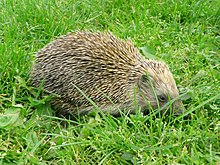Southern white-breasted hedgehog
| Southern white-breasted hedgehog[1] | |
|---|---|

| |
| Scientific classification | |
| Domain: | Eukaryota |
| Kingdom: | Animalia |
| Phylum: | Chordata |
| Class: | Mammalia |
| Order: | Eulipotyphla |
| Family: | Erinaceidae |
| Genus: | Erinaceus |
| Species: | E. concolor
|
| Binomial name | |
| Erinaceus concolor Martin, 1838
| |

| |
| Range of the southern white-breasted hedgehog (red) | |
The southern white-breasted hedgehog (Erinaceus concolor), sometimes referred to as white-bellied hedgehog or white-chested hedgehog, is a hedgehog native to Eastern Europe and Southwestern Asia. These hedgehogs are becomingly increasingly popular as pets in the United States and Iran.[3]
Description
[edit]It is very similar in appearance to the European hedgehog (E. europaeus), but it has a white spot on its chest that easily distinguishes them. They weigh between 680 to 900 grams. Their body weight drops no lower than 600 grams during hibernation.[4]
Origins
[edit]The white breasted hedgehog diverged from a split lineage due to geographical features. The Caucasus Mountains played a significant role in dividing the white breasted hedgehog to southern and northern locations. North of the Caucasus Mountains lies Russia, which is where some white breasted hedgehogs are located. Other hedgehogs live in Turkey, Iran, and Israel due to the distribution of this species.[5]

Taxonomy
[edit]For a long time these two species were considered to be one. The northern white-breasted hedgehog of Eastern Europe and Russia was formerly recognized as a subspecies of the southern white-breasted hedgehog but newer investigations see both as different species. The southern white-breasted hedgehog and European hedgehog can hybridize.
Similar white-breasted hedgehogs
[edit]Some relatives to the southern white breasted hedgehog consist of the west European (Erinaceus europaeus) and northern white-breasted (Erinaceus roumanicus). These two species are creating gene flow through reproducing with one another and result in generating hybrids. Gene studies were conducted and discovered that the northern southern white breasted hedgehogs have more expressed genes than the west European hedgehog in the hybrid species.[6]
Behaviour
[edit]Like most hedgehogs, the southern white-breasted hedgehog’s habitat ranges from deciduous forests to parks and gardens. Their diet is the same as well, consisting mostly of insects, slugs, snails, and worms. They also prey upon toxic beetles which they happen to be immune to. The breeding period is between March and July, with up to 7 offspring being produced after a gestation period of about 6 weeks. They hibernate from November to March.[7] Unlike its European counterpart, the southern white-breasted hedgehog never digs dens. It prefers building grass nests in secluded places.
Parasites
[edit]The species carries a host of ectoparasites such as ticks and fleas and due to their increasing popularity as exotic pets, this can lead to a potential transmission of zoonotic diseases.[8] Lungworm is another type of parasite in the southern white breasted hedgehog. There are two specific types of lungworms that these hedgehogs can contract Crenosoma striatum and Capillaria aerophila. Southern white breasted hedgehogs can have one or both types of lungworm infections that can be life threatening. Some symptoms of lungworm consist of weight loss, trouble breathing, and less physical activities. Scientists discovered a successful treatment plan for deworming the southern white breasted hedgehog by giving a single dose of Moxidectin/Praziquantel.[9]
Bartonella infection, which is an infection caused by the bacteria Bartonella, was found in 5 out of 57 southern white breasted hedgehogs in a study conducted in 2016. This study was the first to find Bartonella DNA in hedgehogs.[10]
References
[edit]- ^ Hutterer, R. (2005). Wilson, D.E.; Reeder, D.M. (eds.). Mammal Species of the World: A Taxonomic and Geographic Reference (3rd ed.). Johns Hopkins University Press. pp. 213–214. ISBN 978-0-8018-8221-0. OCLC 62265494.
- ^ Amori, G.; Hutterer, R.; Kryštufek, B.; Yigit, N.; Mitsainas, G.; Palomo, L. (2021). "Erinaceus concolor". IUCN Red List of Threatened Species. 2021: e.T40605A197506348. doi:10.2305/IUCN.UK.2021-1.RLTS.T40605A197506348.en. Retrieved 11 November 2021.
- ^ Kazemi-Darabadi, Siamak; Akbari, Ghasem; Ebrahimi, Erfan; Zangisheh, Mahsa (December 2018). "Computed Tomographic Anatomy and Topography of the Lower Respiratory System of the Southern White-Breasted Hedgehog (Erinaceus concolor)". Iranian Journal of Veterinary Surgery. 13 (2). doi:10.22034/ivsa.2018.137920.1150.
- ^ "Southern white-breasted hedgehog". D.T.R.O.O.W. (in Indonesian). 2015-05-30. Retrieved 2024-04-12.
- ^ Seddon, J. M.; Santucci, F.; Reeve, N.; Hewitt, G. M. (2002-05-01). "Caucasus Mountains divide postulated postglacial colonization routes in the white-breasted hedgehog, Erinaceus concolor". Journal of Evolutionary Biology. 15 (3): 463–467. doi:10.1046/j.1420-9101.2002.00408.x. ISSN 1010-061X.
- ^ Zolotareva, Katerina I; Belokon, Mariana M; Belokon, Yuri S; Rutovskaya, Marina V; Hlyap, Ludmila A; Starykov, Vladimir P; Politov, Dmitry V; Lebedev, Vladimir S; Bannikova, Anna A (2020-12-05). "Genetic diversity and structure of the hedgehogsErinaceus europaeusandErinaceus roumanicus: evidence for ongoing hybridization in Eastern Europe". Biological Journal of the Linnean Society. 132 (1): 174–195. doi:10.1093/biolinnean/blaa135. ISSN 0024-4066.
- ^ "Southern white-breasted hedgehog". D.T.R.O.O.W. (in Indonesian). 2015-05-30. Retrieved 2024-04-12.
- ^ Girisgin, V., Senlik, B., Aydin, L., & Cirak, V. Y. (2015, July 7). Ectoparasites of hedgehogs (Erinaceus concolor) from Turkey. Vetline. Retrieved October 27, 2023, from https://www.vetline.de/ectoparasites-of-hedgehogs-erinaceus-concolor-from-turkey DOI10.2376/0005-9366-128-315
- ^ Adam, Nitzan; Eshar, David (April 2024). "Use of a commercial oral moxidectin plus praziquantel combination for treatment of the respiratory nematode Crenosoma striatum in rescued Southern white-breasted hedgehogs (Erinaceus concolor)". Journal of Exotic Pet Medicine. 48: 17–19. doi:10.1053/j.jepm.2023.11.001.
- ^ Marciano, Odelya; Gutiérrez, Ricardo; Morick, Danny; King, Roni; Nachum-Biala, Yaarit; Baneth, Gad; Harrus, Shimon (2016-04-13). "Detection of Bartonella spp. in wild carnivores, hyraxes, hedgehog and rodents from Israel". Parasitology. 143 (10): 1232–1242. doi:10.1017/s0031182016000603. ISSN 0031-1820. PMID 27210612.

